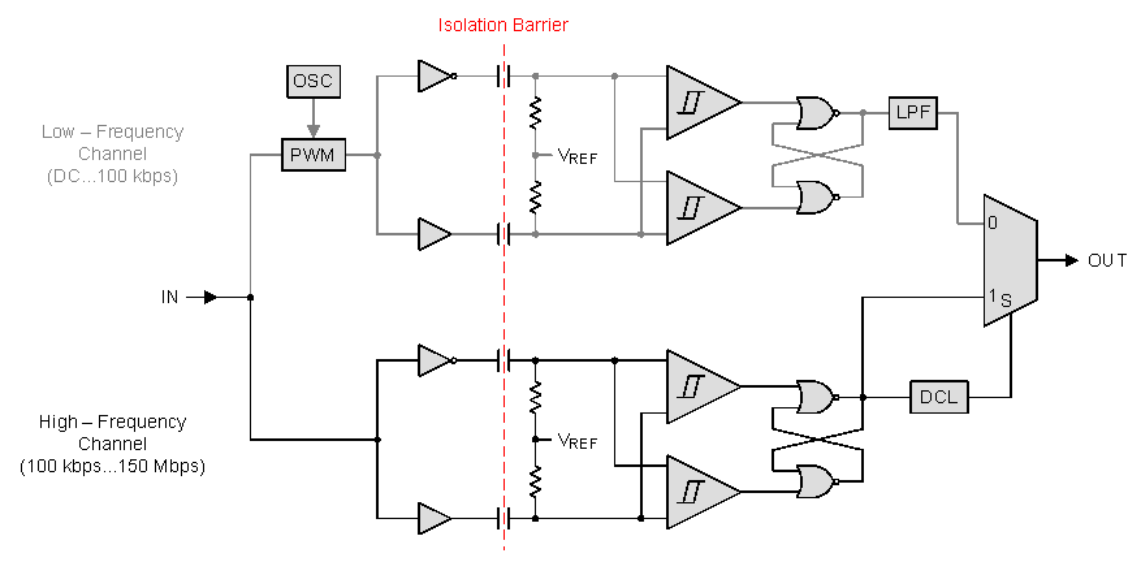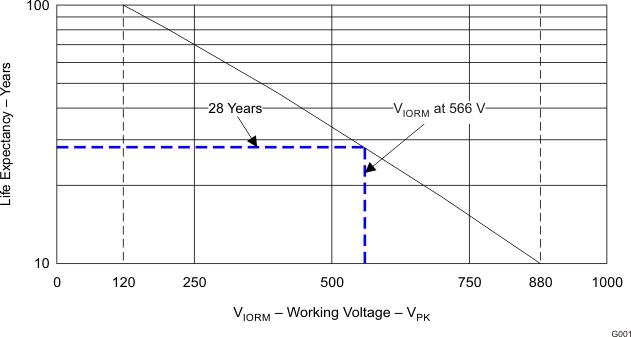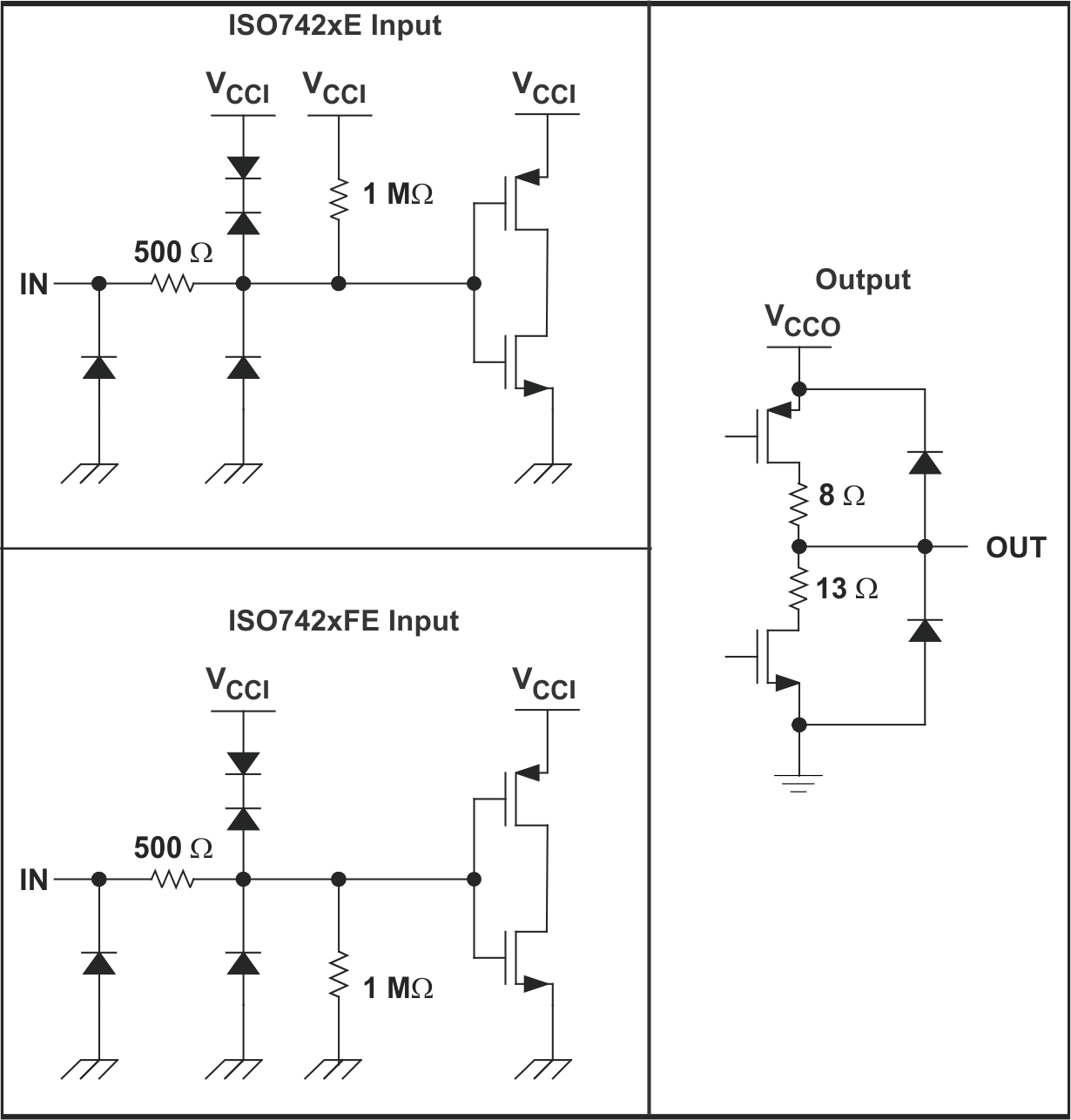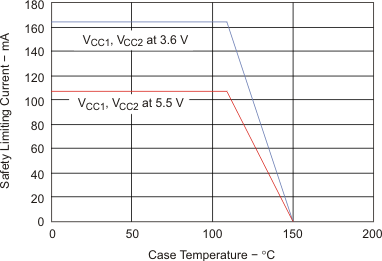SLLSE45F December 2010 – July 2015 ISO7420E , ISO7420FE , ISO7421E , ISO7421FE
PRODUCTION DATA.
- 1 Features
- 2 Applications
- 3 Description
- 4 Revision History
- 5 Pin Configuration and Functions
-
6 Specifications
- 6.1 Absolute Maximum Ratings
- 6.2 ESD Ratings
- 6.3 Recommended Operating Conditions
- 6.4 Thermal Information
- 6.5 Electrical Characteristics: VCC1 and VCC2 = 5 V ± 10%
- 6.6 Electrical Characteristics: VCC1 = 5 V ± 10%, VCC2 = 3.3 V ± 10%
- 6.7 Electrical Characteristics: VCC1 = 3.3 V ± 10%, VCC2 = 5 V ± 10%
- 6.8 Electrical Characteristics: VCC1 and VCC2 = 3.3 V ± 10%
- 6.9 Power Dissipation Characteristics
- 6.10 Switching Characteristics: VCC1 and VCC2 = 5 V ± 10%
- 6.11 Switching Characteristics: VCC1 = 5 V ± 10%, VCC2 = 3.3 V ± 10%
- 6.12 Switching Characteristics: VCC1 = 3.3 V ± 10%, VCC2 = 5 V ± 10%
- 6.13 Switching Characteristics: VCC1 and VCC2 = 3.3 V ± 10%
- 6.14 Typical Characteristics
- 7 Parameter Measurement Information
- 8 Detailed Description
- 9 Applications and Implementation
- 10Power Supply Recommendations
- 11Layout
- 12Device and Documentation Support
- 13Mechanical, Packaging, and Orderable Information
Package Options
Refer to the PDF data sheet for device specific package drawings
Mechanical Data (Package|Pins)
- D|8
Thermal pad, mechanical data (Package|Pins)
Orderable Information
8 Detailed Description
8.1 Overview
The isolator in Figure 19 is based on a capacitive isolation barrier technique. The I/O channel of the device consists of two internal data channels, a high-frequency channel (HF) with a bandwidth from 100 kbps up to
150 Mbps, and a low-frequency channel (LF) covering the range from 100 kbps down to DC. In principle, a single- ended input signal entering the HF-channel is split into a differential signal via the inverter gate at the input. The following capacitor-resistor networks differentiate the signal into transients, which then are converted into differential pulses by two comparators. The comparator outputs drive a NOR-gate flip-flop whose output feeds an output multiplexer. A decision logic (DCL) at the driving output of the flip-flop measures the durations between signal transients. If the duration between two consecutive transients exceeds a certain time limit, (as in the case of a low-frequency signal), the DCL forces the output-multiplexer to switch from the high- to the low-frequency channel.
Because low-frequency input signals require the internal capacitors to assume prohibitively large values, these signals are pulse-width modulated (PWM) with the carrier frequency of an internal oscillator, thus creating a sufficiently high frequency signal, capable of passing the capacitive barrier. As the input is modulated, a low-pass filter (LPF) is needed to remove the high-frequency carrier from the actual data before passing it on to the output multiplexer.
8.2 Functional Block Diagram
 Figure 19. Conceptual Block Diagram of a Digital Capacitive Isolator
Figure 19. Conceptual Block Diagram of a Digital Capacitive Isolator
8.3 Feature Description
ISO742x are available in multiple channel configurations and default output state options to enable wide variety of application uses.
| PRODUCT | DATA RATE | DEFAULT OUTPUT | RATED TA | CHANNEL DIRECTION |
|---|---|---|---|---|
| ISO7420E | 50 Mbps | High | –40°C to 125°C | Same |
| ISO7420FE | Low | |||
| ISO7421E | High | Opposite | ||
| ISO7421FE | Low |
8.3.1 Insulation and Safety-Related Specifications for D-8 Package
over recommended operating conditions (unless otherwise noted)| PARAMETER | TEST CONDITIONS | MIN | TYP | MAX | UNIT | ||
|---|---|---|---|---|---|---|---|
| L(I01) | Minimum air gap (clearance) | Shortest terminal-to-terminal distance through air | 4 | mm | |||
| L(I02) | Minimum external tracking (creepage) | Shortest terminal-to-terminal distance across the package surface | 4 | mm | |||
| CTI | Tracking resistance (comparative tracking index) | DIN EN 60112 (VDE 0303-11); IEC 60112 | >400 | V | |||
| Minimum internal gap (internal clearance) | Distance through the insulation | 0.014 | mm | ||||
| RIO | Isolation resistance, input to output(1) | VIO = 500 V, TA = 25°C | >1012 | Ω | |||
| VIO = 500 V, 100°C ≤ TA ≤ max | >1011 | Ω | |||||
| CIO | Barrier capacitance, input to output(1) | VIO = 0.4 sin (2πft), f = 1 MHz | 1 | pF | |||
| CI | Input capacitance(2) | VI = VCC/2 + 0.4 sin (2πft), f = 1 MHz, VCC = 5 V | 1 | pF | |||
NOTE
Creepage and clearance requirements should be applied according to the specific equipment isolation standards of an application. Care should be taken to maintain the creepage and clearance distance of a board design to ensure that the mounting pads of the isolator on the printed-circuit board do not reduce this distance.
Creepage and clearance on a printed-circuit board become equal in certain cases. Techniques such as inserting grooves and/or ribs on a printed circuit board are used to help increase these specifications.
8.3.2 Insulation Characteristics
over recommended operating conditions (unless otherwise noted)| PARAMETER(1) | TEST CONDITIONS | SPECIFICATION | UNIT | |
|---|---|---|---|---|
| DIN V VDE V 0884-10 (VDE V 0884-10):2006-12 | ||||
| VIORM | Maximum workingisolation voltage | 566 | VPEAK | |
| VPR | Input-to-output test voltage | Method a, After environmental tests subgroup 1, VPR = VIORM x 1.6, t = 10 s, Partial Discharge < 5 pC |
906 | VPEAK |
| Method b1, VPR = VIORM x 1.875, t = 1 s (100% Production test) Partial discharge < 5 pC |
1062 | |||
| After Input/Output safety test subgroup 2/3, VPR = VIORM x 1.2, t = 10 s, Partial discharge < 5 pC |
680 | |||
| VIOTM | Maximum transient isolation voltage | VTEST = VIOTM = 4242 VPK
t = 60 sec (qualification) t= 1 sec (100% production) |
4242 | VPEAK |
| RS | Isolation resistance | VIO = 500 V at TS = 150°C | >109 | Ω |
| Pollution degree | 2 | |||
| UL 1577 | ||||
| VISO | Maximum withstand isolation voltage | VTEST = VISO = 2500 VRMS, t = 60 sec (qualification); VTEST = 1.2 x VISO = 3000 VRMS, t = 1 sec (100% production) |
2500 | VRMS |
Table 1. IEC 60664-1 Ratings Table
| PARAMETER | TEST CONDITIONS | SPECIFICATION |
|---|---|---|
| Basic isolation group | Material group | II |
| Installation classification | Rated mains voltage ≤ 150 VRMS | I–IV |
| Rated mains voltage ≤ 300 VRMS | I–III |
8.3.3 Regulatory Information
| VDE | CSA | UL | CQC |
|---|---|---|---|
| Certified according to DIN V VDE V 0884-10 (VDE V 0884-10):2006-12 and DIN EN 61010-1 (VDE 0411-1):2011-07 | Approved under CSA Component Acceptance Notice 5A, IEC 60950-1, and IEC 61010-1 | Recognized under UL 1577 Component Recognition Program | Certified according to GB 4943.1-2011 |
| Basic Insulation; Maximum Transient Isolation Voltage, 4242 VPK; Maximum Working Isolation Voltage, 566 VPK |
2500 VRMS Isolation Rating; Basic insulation per CSA 60950-1-07+A1 and IEC 60950-1 2nd Ed+A1, 384 VRMS maximum working voltage; CSA 61010-1-04 and IEC 61010-1 2nd Ed, 300 VRMS maximum working voltage for basic insulation and 150 VRMS for reinforced insulation |
Single Protection Isolation Voltage, 2500 VRMS(1) | Basic Insulation, Altitude ≤ 5000 m, Tropical Climate, 250 VRMS maximum working voltage |
| Certificate number: 40016131 | Master contract number: 220991 | File number: E181974 | Certificate number: CQC14001109540 |
8.3.4 Life Expectancy vs Working Voltage
 Figure 20. Life Expectancy vs Working Voltage
Figure 20. Life Expectancy vs Working Voltage
8.3.5 Safety Limiting Values
Safety limiting intends to prevent potential damage to the isolation barrier upon failure of input or output circuitry. A failure of the I/O can allow low resistance to ground or the supply and, without current limiting, dissipate sufficient power to overheat the die and damage the isolation barrier, potentially leading to secondary system failures.| PARAMETER | TEST CONDITIONS | MIN | TYP | MAX | UNIT | |
|---|---|---|---|---|---|---|
| IS | Safety input, output, or supply current | θJA = 212°C/W, VI = 5.5 V, TJ = 150°C, TA = 25°C | 107 | mA | ||
| θJA = 212°C/W, VI = 3.6 V, TJ = 150°C, TA = 25°C | 164 | |||||
| TS | Maximum safety temperature | 150 | °C | |||
The safety-limiting constraint is the absolute-maximum junction temperature specified in the Absolute Maximum Ratings table. The power dissipation and junction-to-air thermal impedance of the device installed in the application hardware determines the junction temperature. The assumed junction-to-air thermal resistance in the Thermal Information table is that of a device installed in the JESD51-3, Low-Effective-Thermal-Conductivity Test Board for Leaded Surface-Mount Packages and is conservative. The power is the recommended maximum input voltage times the current. The junction temperature is then the ambient temperature plus the power times the junction-to-air thermal resistance.
8.4 Device Functional Modes
Table 2. Functional Table(1)
| VCCI | VCCO | INPUT INA, INB |
OUTPUT OUTA, OUTB |
|
|---|---|---|---|---|
| ISO7420E / ISO7421E | ISO7420FE / ISO7421FE | |||
| PU | PU | H | H | H |
| L | L | L | ||
| Open | H(2) | L(3) | ||
| PD | PU | X | H(2) | L(3) |
| X | PD | X | Undetermined | Undetermined |
8.4.1 Device I/O Schematic
 Figure 22. Device I/O Schematics
Figure 22. Device I/O Schematics
